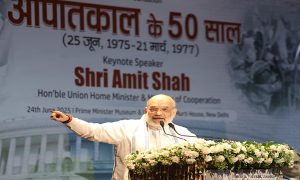In today’s era, semiconductors or chips/integrated circuits (ICs) are the lifeblood of all digital products. Perhaps, India imports 100 per cent of its semiconductors. No country has so far established complete autonomy in the semiconductor value chain. However, Indian companies such as Tata and others have recently announced their aspirations to increase their lead in the design and ramp up manufacturing.
The Tata Group is looking to enter semiconductor manufacturing and has set up a business to seize the opportunity, Tata Group Chairman N Chandrasekaran said on August 9, 2021.
Chandrasekaran said the global supply chain, which is currently heavily dependent on China, will see a major change in the post-pandemic world, with businesses shifting their dependencies to other countries.
Finance Minister Nirmala Sitharaman on Thursday, August 12, 2021, during CII Annual Meeting, said that the industry needs to bring chip manufacturing to India in view of the global semiconductor shortage affecting manufacturing across the world. FM Sitharaman also said that the industry needs to focus on a self-reliant India plan for its energy needs.
Need of Semiconductors
The global semiconductor or chip supply crisis, which began after the Covid pandemic in 2020, has intensified over the past few months and major companies in many industries are struggling to meet the rising demand for electronic goods and components. Semiconductor manufacturing requires high investment and there is no such facility in India as of now.
Setting up of Semiconductor Wafer Fabrication (FAB) unit is a capital intensive proposition. The investment required to set up a FAB can range from $3 billion to $6 billion, depending on the technology node and wafer capacity of the FAB.
What is behind the global chip shortage?
Chip, or semiconductor, which is the brain-centre of any electronic technology, have found itself a rarity in the post-Covid era, with many large factories shutting down in places like South Korea and Taiwan. This has created a buzz in demand that these foundries were unable to satisfy once they opened.
On the one hand, the pandemic caused an increase in the demand for electronic devices like computers, laptops and smartphones etc.
Manufacturing and logistical constraints meant that the situation was only exacerbated. This shortage that started last year is expected to continue till 2022, and to prevent such a situation in future, many companies are planning to reduce their reliance on only a few big factories which supply to the whole world.
$100 Billion Opportunity in India by 2025
The global semiconductor market is projected to grow from $340 billion in 2015 to $650 billion in 2025, with a CAGR of 6.7%. Taiwan is the world’s largest manufacturer of semiconductors, with a market share of over 50 per cent.
Today, India’s semiconductor demand stands at around $24 billion and is expected to reach $100 billion by 2025. Presently the country’s semiconductor demand is entirely met through imports. With the growing technology and the advent of IoT and 5G technology in India, the demand for semiconductor chips is increasing. India is set to witness a significant demand spike by 2025 driven by electronic manufacturing, IoT products and data centre facilities. Semiconductor shortages in the pandemic and the new geopolitical realities of semiconductor supply chains further exacerbate the need to develop reliable and trusted sources for semiconductors.
Government Initiatives
– In the Union Budget 2017-18, the Government of India increased the allocation for incentive schemes such as the Modified Special Incentive Package Scheme (M-SIPS) and the Electronic Development Fund (EDF) to Rs 745 crore (US$ 111 million) for providing a boost to the semiconductor as well as electronics manufacturing industry.
– The Union Cabinet approved an incentive of up to Rs 10,000 crore for investors by amending the Modified Special Incentive Package Scheme (M-SIPS), to further encourage investment in the electronics sector, generate employment and reduce dependence on imports.
– The Ministry of Electronics and Information Technology is planning to revise its policy framework, wherein the government will play a more active role in developing the sector by attracting more private players and providing initial capital to make India a global semiconductor hub.
– The then Union Minister of Electronics and Information Technology Ravi Shankar Prasad inaugurated an Electropreneur Park at the South Campus of Delhi University, which would incubate 50 early-stage start-ups and create at least five global companies in five years.




























 WhatsApp us
WhatsApp us